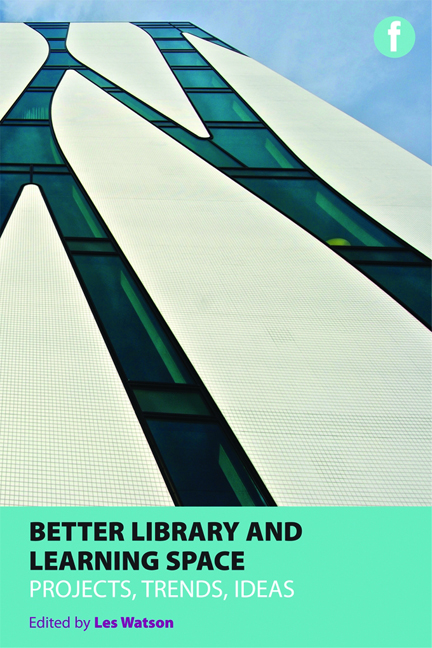Book contents
- Frontmatter
- Contents
- Case studies
- Acknowledgements
- Contributors
- Introduction – about this book
- PART 1 PROJECTS AND TRENDS
- PART 2 TRENDS AND IDEAS
- PART 3 IDEAS AND FUTURES
- Introduction
- 11 Beyond space: access is all – or is it?
- 12 Thinking inside the box
- 13 Nothing has changed/everything has changed – the enduring aspects of learning
- 14 Books, nooks and MOOCs
- 15 The researcher's view: context is critical
- 16 Libraries in the network society: evolution, revolution, extinction?
- 17 Powered by learning: developing models of provision to meet the expectations of new generations of students
- 18 The library has left the building
- 19 Beyond analogue: the learning studio as media-age library
- 20 3D libraries for 3D smarting
- 21 Learning landscapes, the library and the University of Lincoln: efficiency, effectiveness, expression and experimentation
- 22 Viral design: learners building better environments together
- 23 The interior designer's view
- 24 Furniture fit for the future – a brief exploration of library and learning furniture today and for the coming generation
- 25 Conclusions
- Index
18 - The library has left the building
from PART 3 - IDEAS AND FUTURES
Published online by Cambridge University Press: 08 June 2018
- Frontmatter
- Contents
- Case studies
- Acknowledgements
- Contributors
- Introduction – about this book
- PART 1 PROJECTS AND TRENDS
- PART 2 TRENDS AND IDEAS
- PART 3 IDEAS AND FUTURES
- Introduction
- 11 Beyond space: access is all – or is it?
- 12 Thinking inside the box
- 13 Nothing has changed/everything has changed – the enduring aspects of learning
- 14 Books, nooks and MOOCs
- 15 The researcher's view: context is critical
- 16 Libraries in the network society: evolution, revolution, extinction?
- 17 Powered by learning: developing models of provision to meet the expectations of new generations of students
- 18 The library has left the building
- 19 Beyond analogue: the learning studio as media-age library
- 20 3D libraries for 3D smarting
- 21 Learning landscapes, the library and the University of Lincoln: efficiency, effectiveness, expression and experimentation
- 22 Viral design: learners building better environments together
- 23 The interior designer's view
- 24 Furniture fit for the future – a brief exploration of library and learning furniture today and for the coming generation
- 25 Conclusions
- Index
Summary
Introduction
In Chapter 5 we wrote about the new and more active processes of inspiration, creation and sharing that should be the main focus of future libraries. We emphasized the importance of designing new and exciting ways to present the collection, of adding valuable significance, and making it possible for people to share acquired knowledge and insights with other users. We also put forward the view that this new approach will inevitably lead to different design criteria for libraries, and concluded that we need experts from other disciplines to help draw up these new criteria. They can help us to relinquish the classical use of the building and to explore new and inspiring ways of using space, of the kind we see in BK City. For us, this is the example par excellence of a place where many forms of exploration and serendipity are possible.
In this chapter we will explore territory away from the beaten track. When all is said and done, do we really need a building? Can we work without the traditional arrangement of the library? Can modern technology liberate us from that hidebound, passive presentation of library collections? This kind of presentation does not sufficiently invite people to learn and discover, and it is this inviting quality that will be so essential in the library of the future.
We will explore these issues with reference to two sample projects. The first, the ‘Context Library’, focuses on designing exciting search strategies for the public library collection, appropriate to the different ways in which people absorb knowledge and information. The second project is also about the exchange of knowledge and information but it is organized in a completely different way. As we examine these projects, we not only turn our backs on the traditional presentation of (public) library collections but also on the traditional library building.
The Context Library
Traditionally, library collections are placed on bookshelves by librarians according to the centuries-old principles of organization: alphabetic (fiction) or systematic (non-fiction). It remains an effective way to store and retrieve books, but it does not really invite one to explore or to discover meaningful links in the collection. To quote Lankes (2011), ‘libraries should see themselves not as grocery stores but as kitchens’.
- Type
- Chapter
- Information
- Better Library and Learning SpaceProjects, trends and ideas, pp. 209 - 214Publisher: FacetPrint publication year: 2013



